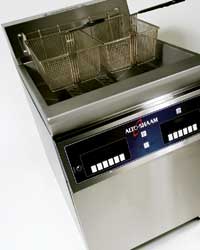
What type of food do you serve?
The type of food you fry often determines what fryer fits your operation. A fryer with an open pot configuration, in which the heating units are outside the frypot, collects food sediment internally. These are best for lightly battered or non-battered items, such as French fries. The tube-type fryer has heating tubes inside the frypot; sediment collects below them in the “cold zone” at the bottom of the tank. It’s well suited for heavily breaded items, like chicken or fish. Flat-bottom fryers have no sediment collection area, so they’re best for lighter items that will float to the top of the tank, such as wet-battered fish or tempura vegetables. If you’re going to be frying two strongly flavored foods at the same time (such as fish and onion rings), you’ll want a “split-pot” model with twin fryer tanks to avoid flavor transfer.
What oil do you use?

Alto-Shaam's Frytech ASF-756
The fryer you buy may also determine what fat you’ll use. For example, fryers that automatically replenish the medium, like Frymaster’s Protector model, use liquid oil, while other fryers can use either a liquid or solid shortening. If you decide to go with solid shortening, make sure the model has an automatic fat melt cycle, like the Hobart HG65 and Alto-Shaam ASF-75 models. With any new fryer, you should do some test runs to determine which frying medium provides the best flavor, filtration and length of usage. For operators who are avoiding trans fats, there are a number of trans fat-free oils to choose from, including ACH’s Frymax ZT and Bunge’s Nutra-Clear NT. Performance for these oils is comparable to that of traditional hydrogenated oils.
What’s the fryer’s recovery time?
Simply put, recovery time is the time it takes a fryer to return to optimum frying temperature after product has been added—a particularly important factor during rush periods. In general, fryers that can acceptably fry food at a lower temperature will recover faster, allowing you to turn out more loads per hour. However, each manufacturer calculates recovery time a little differently, so compare models carefully.
What about maintenance?
More so than with other equipment, proper fryer maintenance is essential. Besides daily filtration and cleaning, most manufacturers recommend a weekly boilout. Check the filtration and drainage setups on the fryer you’re planning to buy to ensure they’ll fit in your kitchen space. The more wet-battered or heavily breaded items you fry, the more often you’ll need to filter the oil. If you plan on removing used oil manually through the filter pan assembly, check the pan for durability, ease of removal and lightness of weight. You may also consider investing in a filter pan dolly. If you already use a shortening shuttle, you’ll want to make sure that it’s compatible with your new fryer.
Click here for the comparison chart.
Members help make our journalism possible. Become a Restaurant Business member today and unlock exclusive benefits, including unlimited access to all of our content. Sign up here.